
Bath Salts and Designer Drugs
Bath salts are a unique collection of designer chemicals. The name stems from the occasions in which these drugs were supposedly disguised as bath salts. For example, some of them might have been sold as bath salt, intended to be used after a bath, or after swimming. Today, bath salts are recognized as having health benefits. They are often sold as ” Dead Sea salt” or ” salts ” from Amazons “.
Synthetic bath salts, and bath salts in general, first became well-known to the public in 2021 when they appeared on an episode of Dateline NBC. It was a story that attracted widespread media coverage and commentary. The substance featured was a synthetic cathinone called “bath salts”. At that time bath salt was sold by “specialty” chemists who claimed that the chemical compound contained numerous therapeutic properties.
Except for one chemical called 25I-NBOMe, bath salt is not a known drug with a medical use. That compound does not occur in nature. It is manufactured synthetically. So far, there are no known interactions with food or water, at any dose, with any prescription or nonprescription drug. So bath salt is “safe”, according to the FDA.
However, bath salt drugs are the target of abuse. It is easy to buy bath salt drugs online, in retail stores, and in self-contained units that are available for home use. A simple search on the Internet for the term “bath salts” reveals links to websites containing pages describing the abuse of bath salts with all types of dangerous substances.
The most common type of bath salts addiction is the so-called hot bath addiction. Some people have reported feeling refreshed after consuming a small amount of bath salts. It is not clear whether this effect is medically significant. It could be the result of the product working like a stimulant to alert the user’s body of a cold or other type of flu, rather than revitalizing the user’s body.
Other symptoms of bath salt addiction include depression, irritability, restlessness, nervousness, and changes in behavior such as violent behavior. In some cases, the user has been reported to have hallucinations and delusions. These symptoms can be attributed, at least in part, to the use of cathinone (a new type of drug) or of the local anesthetic used during massage therapy. There is some evidence that cathinone use can cause the production of diphenhydramine, a powerful serotonin and norepinephrine reuptake inhibitor found in the brain and responsible for many of the symptoms of ADHD and substance abuse. The increased level of dopamine released into the bloodstream is thought to be responsible for these symptoms.
Recently, bath salt producers have begun using new kinds of ingredients in their products. Some of these ingredients, such as guarana, have shown promise in experimental studies with ADHD children. It has not, however, been established whether or not these designer drugs are safe or effective. Designer drugs have, in the past, been tested on animals without success. Although the FDA does not normally regulate the sale of pharmaceuticals designed to treat conditions such as ADHD, it is considering new types of ingredients for designer drugs and investigating the issue of bath salt addiction.
There is no doubt that bath salts contain elements that are potentially addictive. Their addictive properties make them very attractive to those who want an easy way to relax and escape from their stressful day. They represent an excellent opportunity to satisfy the “need” for relaxation that may exist in people without personal responsibility for their well-being. Unfortunately, bath salt addiction also represents an opportunity for unscrupulous marketers to take advantage of this “lazy man’s” status. If you or someone you know is addicted to bath salts, it is important to understand how to escape from the cycle of dependence and the health risks associated with its use.

0 Comments